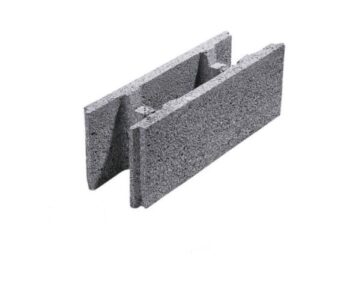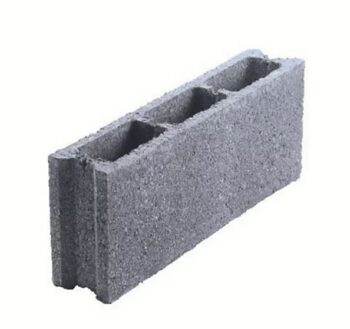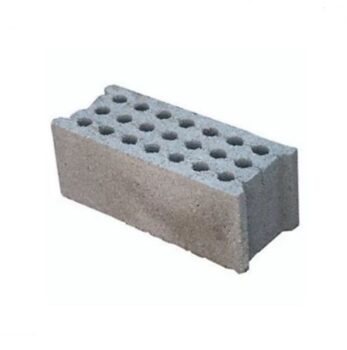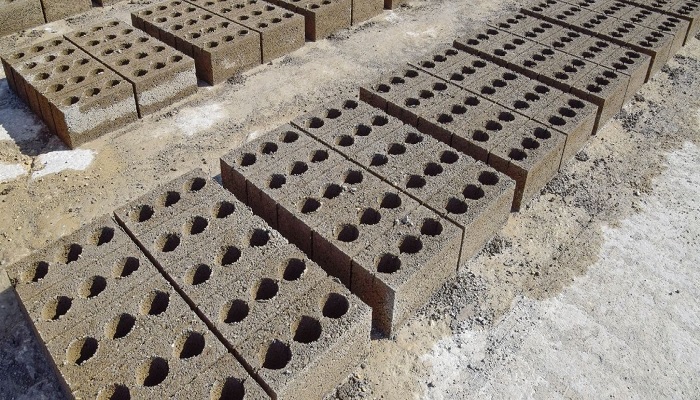Robust, affordable and easy to install, cinder block is the ideal material for building or extending a home. Before you make your real estate project a reality, you want to take stock of this product? We tell you everything in this guide to buying the best cinder blocks.
Here is our commitment, to make sure that we provide the best user experience and content quality:
You can support us by using our links to make your purchases (at no extra cost to you)! This sometimes earns us a commission which allows us to remain independent. More about us
Our selection
"Easily recognizable thanks to its H shape, this breeze block is mainly used for formwork, but also for retaining walls."
"This hollow concrete block B40 is ideal for the assembly of walls or external low walls. It can also be used for pool walls."
"In the cinder block family, the perforated block is the heaviest. This category of agglo is required for the construction of basements, but also for…"
"This corner block or post block is mainly used to create corners in a construction or an extension. The particularity of this block is that…"

Easily recognizable thanks to its H shape, this breeze block is mainly used for formwork, but also for retaining walls.
2,20 £ on CastoramaAlso called formwork block, the formwork block allows to make very quickly retaining walls or lost formwork in masonry. The hollow shape of this block allows it to receive steel reinforcements on which the concrete will be poured to solidify the whole structure.
The strength class of this hollow block is not mentioned, but one thing is certain, it is capable of withstanding great pressure. This block is designed to support the entire weight of a small house or retaining wall. You can also use it to reinforce various structures on your property.

This hollow concrete block B40 is ideal for the assembly of walls or external low walls. It can also be used for pool walls.
0,91 £ on CastoramaThis hollow concrete block is presented in its most classic form. Indeed, it is composed of regular cells which end with flanges. It is thanks to these notches that we can realize the vertical joints between the blocks. The present model can be cut to a third or to 2/3. In this sense, it can be used for different purposes on a construction site or house extension.
With a resistance class of B40, this hollow concrete block promises a resistance of 40 kg/cm². Despite its shape and thickness, this block can be used to create a load-bearing wall or not, a fence wall or a garage wall.

In the cinder block family, the perforated block is the heaviest. This category of agglo is required for the construction of basements, but also for buried basements.
2,32 £ on Castorama
This corner block or post block is mainly used to create corners in a construction or an extension. The particularity of this block is that it can be cut in thirds.
2,24 £ on CastoramaSome building professionals are used to call this corner block, corner block or post block. This block is mainly used to create load-bearing walls, but also vertical ties. In the jargon of the building industry, the chain-linking designates the steel reinforcements which are installed on the periphery of a structure.
As you will notice on the picture, the cells of this corner block are of different sizes. The largest of these cells are used to pass a metal reinforcement through the height. These blocks are known for the reinforcement they bring to the corner of a wall, but especially because they drastically reduce the complexity of the work.
Any specific needs?
The best entry-level cinder block
The best high-end cinder block
The best cinder block for your construction job
Your guide :
Rate this buying guide :By rating this buying guide, you are helping us to reward our best writers. Thank you!
| THE BEST | CHEAP | HIGH END | EXCELLENT | |

In accordance with our commitment, this buying guide does not contain any sponsored products. |
 9/10 |
 8/10 |
 9/10 |
 8/10 |
| OUR SELECTION |
Hollow concrete block
|
Hollow concrete block B40
|
Parpaing perforé B80
|
Concrete hollow corner block
|
|
Easily recognizable thanks to its H shape, this breeze block is mainly used for formwork, but also for retaining walls.
|
This hollow concrete block B40 is ideal for the assembly of walls or external low walls. It can also be used for pool walls.
|
In the cinder block family, the perforated block is the heaviest. This category of agglo is required for the construction of basements, but also for buried basements.
|
This corner block or post block is mainly used to create corners in a construction or an extension. The particularity of this block is that it can be cut in thirds.
|
|
|
Item category
|
Brick block
|
Hollow breeze block
|
Perforated cinder block
|
Corner block
|
|
Net weight
|
0.01 kg
|
0.01 kg
|
0.01 kg
|
0.01 kg
|
|
Dimensions
|
20 x 20 x 50 cm
|
10 x 20 x 50 cm
|
20 x 20 x 50 cm
|
20 x 20 x 50 cm
|
|
Wall construction
|
|
|
|
|
|
Application possible
|
Supporting wall and various fittings
|
Interior and facade load-bearing wall, fence wall, garage wall
|
All foundations and footings of load-bearing and non-load-bearing walls
|
Wall corner reinforcement
|
Help us improve this table:
Report an error, request the addition of a feature to the table, or suggest another product. Thank you for your kindness!
We spend thousands of hours each year studying the major specialized websites, analyzing products of hundreds of brands and reading user feedback to advise you on the best products.
We are a product review company with a single mission: to simplify your buying decisions. Our research and testing helps millions of people every year find the best products for their personal needs and budget.
To support us you can: use our links to make your purchases (which often earns us a small commission), share our articles on social networks, or recommend our site on your blog. Thanks in advance for your support!

The hardness of the block is expressed through the strength class to which it belongs.
The 5 strength classes for concrete block are :
- Class B40: resistance to 40 bars or 40 kg/cm².
- Class B60 : resistance to 60 bars or 60 kg/cm².
- Class B80: resistance to 80 bars or 80 kg/cm².
- Class B120: resistance to 120 bars or 120 kg/cm².
- Class B160: resistance to 160 bars or 160 kg/cm².
The number following the letter B designates the breaking load of the breeze block which is expressed in tons (T). In other words, a linear meter of a B60 breeze block has a resistance of 60 kg/cm².
The standardized breeze blocks are exactly 20 x 25 x 50 cm (L x H x W) for a thickness between 5 to 32.5 cm depending on the type of masonry for which they are intended. As for the rectified breeze blocks, their dimensions are more rigorous, thus quite different from those of the classic breeze blocks.
The ordinary breeze block is composed of gravel, cement, sand and gravel. Some sub-varieties of breeze blocks, however, incorporate insulating materials such as shale, expanded clay or pumice.
Other types of blocks contain silica sand, plaster, lime and aluminum powder. After the manufacturing process and a long firing, the cinder block becomes a compact block that can be used for the foundation of a house, the base of a low wall, walls and even for the walls of a swimming pool.
Many manufacturers have turned their attention to making cinder blocks that offer better insulation than traditional cinder blocks. To give them a good insulating property, cinder blocks are filled with insulation, most often foam insulation (glass wool, rock wool). They can also be filled with a semi-rigid material to which expanded polystyrene or a mineral binder has been added.
Of course, the cost of an insulating breeze block is higher than that of the classic breeze block.
The two standards that frame the creation of agglos are the CE standard and the NF standard. Mandatory, the CE standard ensures that the breeze blocks have been manufactured in strict compliance with European regulations, particularly with regard to the environment. The NF standard, on the other hand, guarantees that the clinkers have been manufactured according to a set of specifications.
The cinder block, also called agglo (for agglomerated concrete) is a parallelepipedic building element. Usually mass-produced in a factory, the breeze block is made from concrete poured into a mold, which is then compacted and baked in an oven.
For the purposes of your construction project, you will need to quantify the blocks. This will allow you to have enough for what you plan to do. For example, for 20 cm high blocks, count about 10 blocks for 1 m² of wall. For 25 cm high blocks, the same m² of wall is equivalent to 8 blocks.
Before building the wall, you need to have made the foundation and the mortar. For the latter, you will need a volume of cement for 3 volumes of sand and half a litre of water.
Here are the steps to follow for the assembly:
If your construction budget is tight, you should know that the use of cinder block is eligible for certain financial aid, the most popular of which is the zero-rate loan or PTZ. If you meet the conditions required by this financing, you will have the opportunity to repay the loan contracted at zero rate in 20 to 25 years. In addition, you can also qualify for the Social Accession Loan or PAS, the property tax exemption and the participation of the employer in the construction effort or PEEC.
Unfortunately, the cinder block is not without its drawbacks. First of all, its particular shape does not allow architectural fantasies. As for the thermal performance of traditional blocks, it leaves a little to be desired. The traditional concrete block is permeable and offers no natural hygrometric regulation.

Hollow blocks are the most used agglos for the creation of a wall or a partition. These blocks have 6 cells and 2 flange-shaped ends which are used to fill the vertical joints.
This category of block has the particularity to be lighter than the other declensions. Their resistance is therefore lower than that of the solid block. In general, hollow blocks belong to strength classes B40 and B60.

Perforated and solid blocks are very heavy. As such, they are most often used for foundations, basements or walls of a buried basement. These blocks are strong enough to support the entire structure of a home. Although the dimensions of hollow blocks and solid blocks are the same, perforated blocks have excellent crushing resistance.
These cinder blocks can support very heavy loads, especially those belonging to strength class B80 to B160.

These are the cinder blocks used for a specific purpose on a house. Among the different types of accessory blocks are:
- The jamb block or rabbet: with a flat end, this cinder block is used for the realization of the openings of the bay windows.
- The formwork block : H-shaped, it is used for formwork or retaining walls.
- The corner block: also called post block, this breeze block is used for the corners of a construction.
- The block of chaining: this breeze block is especially requested to put a lintel on an opening or to carry out the chaining of a house.
The breeze block is probably the most used building material in the UK. Although it is more recent than the brick, its manufacturing process and its appearance have not changed for over a century.
Whether solid, hollow or perforated, cinder block is popular because it is easy to find and, above all, simple to use. Being non-combustible, cinder block offers very good fire resistance. Its density is also very interesting.
Unlike the cinder block, the brick is made from clay that is kneaded, shaped into a rectangular form, dried and fired in a huge oven. This historical material has lost its superbness in front of the cinder block, although it remains very appreciated for its insulating power and especially because it is able to regulate humidity.
Since the brick is less polluting to produce than the breeze block, it is more ecological and even easier to lay.
Brick and cinder block are both very advantageous. If brick offers better thermal performance and is not afraid of humidity, and offers a good regulation of hygrometry, cinder block is much more resistant and is more economical in every aspect.
Brick even has the luxury of being environmentally friendly when filled with insulation. Thus, the best way to reduce construction costs without impacting quality is to use cinder block.

If cinder block is so popular in the construction industry, it is mainly for the many advantages it offers.
A very resistant building material
Yes, cinder block is a building material of a rare robustness. It resists very well to the bad weather and the wear of time. Buildings that are made with quality breezeblocks are able to withstand earthquakes and severe storms. With a good finish, a cinder block wall can last for half a century.
An affordable building material
When it comes to building a home, cinder block is probably the least expensive building material available to you. And, if you are considering building a low-energy home, you may be able to get financial assistance from the government or local communities in your area. A financial boost is always welcome when embarking on such a major life project as building a home.
A non-combustible material
The cinder block is a material that does not fear fire because of its particular composition. In this sense, a house that has caught fire and whose walls are made of cinder block is easier to save from flames.
A very easy material to install
The ease of installation is one of the undeniable advantages of cinder block. Any self-respecting mason can lay cinder block. The result is a reduction in construction time. If you are a bit of a handyman yourself, you can get to work, but start with low walls or partitions for example.
A material compatible with insulation
The breeze block is not very well known for its insulating properties, but this has changed recently. To improve the thermal insulation of the walls, you can add an insulating lining inside or outside. Yes, it costs extra, but it is well worth it.
The diagram below will help you to get an idea of the typical prices for each price range (entry-level, mid-range and high-end).
However, more expensive does not necessarily mean better.
We therefore advise you to always consult our ranking before deciding, rather than blindly relying on price ranges.
Get a professional to assist you
Having trouble estimating the exact number of cinder blocks needed to build your home? Let a professional assist you. The only way to cut thermal bridges with the outside is to insulate the cinder block walls. To do this, you can choose between different types of insulation, the most effective of which are white polystyrene board and cork panels. Many building professionals recommend them.
Insulate your cinder block walls
The longevity of your home is going to depend on the quality of the cinder blocks you purchase. To optimize the durability of your future home, always choose cinder blocks with a minimum strength class of B60.
Don't skimp on costs
Small mishaps often occur on construction sites. So, to avoid putting the work on hold due to lack of breeze blocks, always plan for a few extra m².
Plan for a few extra square meters of cinder blocks
For sure, there are going to be unused cinder blocks when your house is finished. Instead of throwing those cinder blocks away, save them for a future build. You'll be amazed at the variety of structures that can be made with concrete blocks.
Recycle unused cinder blocks
It is not difficult to estimate the number of blocks you need to build 1 m² of wall. If the height of the block is standard, i.e. not more than 20 cm, you need 10 cinder blocks to raise the wall 1 m². For a 200 m² wall, you will need 200 cinder blocks.
Erecting a cinder block wall is a job for professionals, but it is still within your reach. Concrete blocks are assembled with mortar. To make it simple, mark out the space, lay the first layer of mortar, lay the first row of cinder blocks and continue with the next rows.
Different solutions exist to dress the exterior of a cinder block wall. To do so, you have the choice between the classic coating or thesingle layer coatingwhich is applied in only one layer. This second solution is recommended for the time saving it provides.
The breeze block is not very well known for its insulating properties. To improve the insulation of the garage walls, use insulating concrete blocks, or have insulating plates installed by professionals. In a garage, extruded polystyrene sheets will provide the best result.
Every month we help more than 1 000 000 people buy better and smarter.
Copyright © 2022 - Made with ♥ by buyingbetter.co.uk
Your reviews and buying guides 0% advertising, 100% independent!